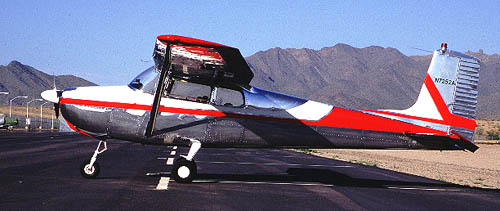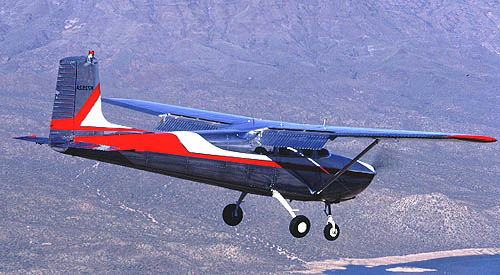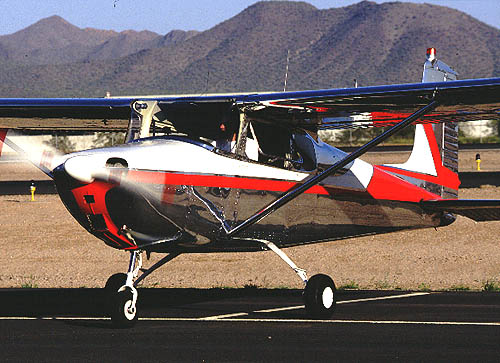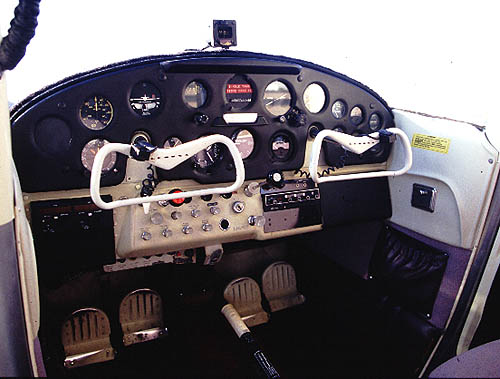
PIREP: 1957 Cessna 172

To many hard-core antiquers and sport aviation enthusiasts, it's hard to look at something like an old Cessna 172 and see anything but a used airplane. How can it be considered a classic? Even a contemporary classic? And why would anyone want to spend any time restoring one?
Look around folks. As old Robert Zimmerman (Dylan) used to intone in his twangy style , "...The times, they are a changin'..." One look at Jim Landers's 1957 C-172 leaves little doubt that the definition of "classic" has to be flexible enough to allow for the accumulation of time: it has been 41 years since the C-172 was introduced. It's age alone should allow its inclusion in the classic genre. Besides, I dare anyone to tell the world a Chevy of the same vintage isn't a classic. If the term fits a Chevy, it sure ought to fit a Cessna.
Undoubtedly, what stops most from considering the C-172 as a "classic" is that it is still in production. The usual mind-set is that anything worthy of restoration shouldn't still be in production.
Applying those criteria, it could be argued that the original C-172 ISN'T still in production. It has gone through literally hundreds of evolutionary changes. Some minor, some major. It's general lines have gone from funky and square to swoopy and stylish. Including its latest incarnation, it has gone through at least three distinct engine changes. Regardless of the endless evolutionary changes, however, it is still the same four seat, easy to fly, utility-oriented machine it was at the beginning. So, although the original 172 may not still be in production, its soul is still alive and well.
 Jim Landers's airplane is a shimmering example
of the 172 at its very inception. Built in 1957, only one year
after the airplane was introduced, it is the quintessential early
Cessna which is usually referred to simply as a "square tail."
Jim Landers's airplane is a shimmering example
of the 172 at its very inception. Built in 1957, only one year
after the airplane was introduced, it is the quintessential early
Cessna which is usually referred to simply as a "square tail."
When the airplane was evolved out of the earlier C-170B taildragger, the two most important changes included moving the little wheel to the other end of the airplane thus creating what Cessna brochures referred to as the "Land-a-Matic" landing gear. The av-advertising of the day was loaded with "...if you can drive, you can fly..." metaphors. The tri-cycle gear took the airplane out of the realm of those experts called pilots and put them in the hands of mere mortals who, if the ads could be believed, needed to know nothing more than was needed to herd their Chevy Belair to the market and back.
With a styling concession to the times, the rounded, art-deco tail of the 170B disappeared to be replaced with a more severe, rectilinear unit more representative of the 1950's. The era of the tail fin was upon us.
The rest of the airframe was basically 170B, including the fastback fuselage and the wonderfully effective Fowler flaps which went down to a full 40°. The gross weight was identical although the useful load went down 45 pounds. The important thing is the airplane was close to being, as advertised, "...if you can drive, you can fly...". It became wildly popular in a matter of months and started a dynasty which endures to this day.
Incidentally, there are some interesting comparisons between a 1957 Cessna 172 and one 20 years newer (172N). For one thing, the base Blue Book value is $25,000 compared to $41,000. The gross weight of the newer aircraft is 100 pounds higher but the useful load is 70 pounds less (940 compared to 870). The newer airplane picks up 6 more gallons of fuel, to 43 gallons and its cruise jumps up to 122 knots (that's what the books say, really!) while the older airplane, which has 145 hp versus 160 hp, will only make 108 knots (also, slightly optimistic). The stall speed drops from 50 knots for the original airplanes to 44 knots for the newer one, probably as a result of the "Camber-Lift" wing introduced in 1973.

The C-172 evolved slowly over the years with most of the styling changes coming one at a time. The square tail, for instance, disappeared in 1960 with the introduction of the 172A. The new swept tail is slightly different than what we see today, because the fuselage shape remained the same. The older fastback fuselage had enough side area that a dorsal fin wasn't needed. When the fuselage was cut down for the "Omnivision" rear windows in 1963 with the 172D, the engineers had to compensate for the loss in side area by attaching a dorsal fin. That became the tail most recognized by the Pepsi Generation.
Incidentally, there's an old wives tale floating around that says the fast back airplanes were faster than the airplanes because the flow was better on the older ones. If that's the case, it's not represented in the specification tables. However, in speaking with engineers around at the time, they'd admit they had to do their work carefully to keep from giving up any speed to marketing changes.
In 1961 the "B" model came out with a float kit as an option. 1961 is an important year, if for no other reason than the fact that the name "Sky Hawk" was introduced. If our references are correct, the term was originally used to designate the more deluxe version of the basic 172. The 172 purists will probably point out that there is, and always have been, two levels of the same airplane; the 172 and the Sky Hawk. To the rest of the world, however, the two aircraft are one in the same.
Electric flaps were introduced in 1964 with the 172E and the 150 hp Lycoming 0-320-E2D replaced the 145 hp Continental 0-300D in 1968. The so-called Camber-Lift wing showed up in 1973 and the in-famous 160 hp 0-320-H2D in 1977 (172N II). No other major changes were made until the aircraft went out of production in 1986, exactly 30 years after its introduction.

Here's an interesting historical trend: The 172 was introduced at $8,750 (base price). Ten years later it was $12,840 (47% increase). 20 years after introduction it was up to $20,750, a 61% increase over the last decade. At shut down in 1986, its window sticker read $53,050 ($74,705 equipped) a whopping 155% increase in the previous ten years. Most of the increase came after 1979.
The current price of $126,000 is an increase of 137% over the last models produced, although that's not exactly an apples to apples comparison because of engine and equipment differences.
None of this means anything to Jim Landers, as he tools around the skies over Phoenix in his immaculate '57 square tail. All he knows is the airplane does what he expects of it and he never pulls up to a gas pump without drawing a crowd. Often the crowd includes owners of later 172s who are attracted to his airplane because of its attractive, period appearance. It didn't always look that way.
Landers says, "When we got the airplane it was painted black and white and, if you saw it following you over the highway, you'd think the highway patrol was clocking you."
The paint was anything but perfect which made little difference to Landers, who, from the beginning had pictured himself returning the airplane to its original factory paint scheme, although he hadn't purchased the airplane as a restoration project.
"I had started flying in a flying club back in 1980 and rented airplanes for a while. Then, in 1988, I decided to buy a Cessna 150. I had a teenage son who needed something to focus on and this was it. By the time he turned sixteen, he had over 180 hours in the airplane. We soloed him on his 16th birthday and the next day he went down to get his drivers license."
Landers and his wife used the 150 for a lot of trips but, "...she had trouble learning to pack small and light, which the 150 demanded."
A new airplane was in the offing and that's where the squaretail came on the scene. It only had 3,400 hours total time and 1,000 hours on the original 0-300 Continental. Most important, it had plenty of room for baggage.
Landers was lucky in that the airplane had spent most of its later years in Texas and Arizona, so, when he began to strip the paint, he found only minor skin corrosion. Also, in working through the airframe he didn't find the usual collection of mouse nests and the pockets of corrosion, they often generate.
Once the airplane was stripped he began the labor intensive task of polishing it. As with anyone who jumps in to that kind of project, Landers quickly developed his own polishing sequence.
"On the bad areas I would start with a concentric stitched edge-polishing wheel, rather than the usual flat polishing buff. I'd use a 5X brand white polishing rough stick. That would knock the worse stuff off. Then I'd use a paint buff on a 1500 rpm buffer with varying grades of 3M polishing compound. At the very end I'd use Finesse-It, which is super fine. To maintain the polish I use a combination which is one part of Blue-Magic to two parts of Finesse-It. I use Sparkle cleaner to get the black polishing stuff off."
Landers says even after flying the airplane for four years, he doesn't consider it a true four place airplane except for local flights. He says the high density altitudes and higher altitude airports in Arizona force him to be very careful about how the airplane is loaded and used. With only 145 hp, he doesn't feel it is wise to load it up to gross and expect it to cope with density altitudes which in areas like Flagstaff often top 10,000 feet.
To those who have never flown an earlier Cessna, their first thoughts on climbing into the cabin is that they are sitting so high. This is an illusion caused by the fact that modern Cessna instrument panels are so much higher than the older ones because of the demands for more places to put more gadgets. Also, the seating position is slightly more erect giving you the impression, you're on a front porch looking down over the nose. In cruise, the nose seems ridiculously low although it's actually in exactly the same place.

The instrument panel itself is probably the most noticeable difference between old and new. When the 172 was introduced, the VOR system was still in its infancy and most approaches were still being shot with low-frequency A-N ranges and surveillance radar. An ADF was a much more usable cross country nav-aid. The panel didn't have to be very deep because there weren't that many avionics gadgets in existence that the space was needed. For that reason, the radios were still mounted low, generally on the pilot's side. The concept of a center stack radio set up hadn't yet developed because there was no need for it.
The panel has a remarkably innocent look to it.
Flying an early 172 is a joy, if only because they are usually lighter and quicker than later ones. Also, despite being slightly lower powered, the 0-300, six-cylinder Continental is so much smoother than the Lycomings it's almost worth the trade-off.
Landers says the Continental's only nagging problem is the accessory section tends to seep oil. The TBO on the engine is supposedly 1800 hours, although Landers's engine decided to break a rod cap bolt and shove a rod through the case at 1,400 hours. It was in the process of rebuilding the engine that he developed some opinions.
"Since the engine hasn't been in Cessnas since 1968, a lot of the overhauled cylinders out there have seen a lot of time. I opted to go with a set of Superior Millenniums just so I wouldn't have to worry about it."
On takeoff, the amount of load on board will determine how the airplane reacts. Flown as Landers flies the airplane, as a two-place airplane with a big baggage compartment, it moves along sprightly and gives a solid 500-600 fpm climb. Although the handbooks say it should do that at gross, most 172 owners know better and plan accordingly.
Landers flight plans 117-120 mph (104 knots) which is only slightly less than what the handbooks said it would do when new. At that speed he's burning less than 8 gallons gallons per hour which, with its 37 gallon tanks gives nearly 4.5 hours.
In terms of flying qualities, a 172 hasn't changed enough to be noticeable in nearly 40 years. The personality that has let it endure for so long was there at the beginning and has gotten better with the addition of items like the later tapered-rod landing gear. The early airplanes give 95% of what the later ones do with slightly lower operating costs. The only penalty is finding room to stack enough radios to make it compatible with today's avionics-intensive IFR environment.
 The early airplanes can deliver most of the
utility. There is, however, something the later airplanes absolutely
cannot deliver. The early square-tails evoke a feeling of a time
past. Of a very young Elvis Presley, the innocence of the Eisenhower
years, of a time when everything, including airplanes were simpler
and just a little more pure. Certainly all of that is worth the
elbow grease it takes to transform a lack-luster old airplane
into a shining representation of the period of its birth. They
may not be true time machines, but dollar-for-dollar, they're
close enough. BD
The early airplanes can deliver most of the
utility. There is, however, something the later airplanes absolutely
cannot deliver. The early square-tails evoke a feeling of a time
past. Of a very young Elvis Presley, the innocence of the Eisenhower
years, of a time when everything, including airplanes were simpler
and just a little more pure. Certainly all of that is worth the
elbow grease it takes to transform a lack-luster old airplane
into a shining representation of the period of its birth. They
may not be true time machines, but dollar-for-dollar, they're
close enough. BD
Cessna 172 (1957) / Cessna 172P (1986)
Cruise, knots 108 /120
Stall 50 /47
Fuel burn, Max Cruise 7.5 /9
Rate of Climb, fpm 660 /700
Service Ceiling 13,300 /13,000
Take-off roll, ft 950 /890
Landing roll, ft 600 /540
Useful load 940 /946
Power Loading, lbs/hp 15.2 /15.0
Wing Loading, lbs/sq. ft. 13.8 /15.1
Engine hp 145 /160
Propeller fixed/ fixed
Landing gear tri/fixed /tri/fixed
Useful fuel, gal. 37 /43
Seating capacity 4 /4Cessna 172, 1957__
Price: $24,750 (new $8,995)
Engine(s), Make/model: Continental 0-300
Horsepower for takeoff: 145
TBO Hours: 1800
Fuel type: 80/100LL
Propeller Make/Type: McCauley, Fixed
Landing gear type: Tri/fixed
Max ramp weight (lbs): 2200
Gross weight (lbs): 2200
Max landing weight (lbs): 2200
Empty weight (lbs): 1260
Usable fuel (gals): 37
Oil capacity (quarts): 5
Wingspan: 35 ft _ in.
Overall length: 25ft. _ in.
Height: 8ft. 5 in.
Wing area (sq. ft.): 159
Wing loading (lbs/sq. ft.): 13.8
Power loading (lbs/hp): 15.2
Wheel track: ft. __in.
Wheel size: 6in.
seating capacity: 4
Cabin doors: 2
Cabin width: 44in.
Cabin height: in.
Baggage capacity (lbs): 50 lbs
· Performance ·
Max level speed (knots): 117
Performance / Altitude (6,500)
Cruise speed (knots):
75% power: 104
65% power: 101
55% power: 98
Max range (with reserve)(nm)
75% power: 395
65% power: 420
55% power: 440
Fuel consumption (gph): gph
75% power: 8.0
65% power: 7.5
55% power: 7.1
Estimated endurance (65% power
w/1 hr reserve)(hrs): 3.9
Stall speed (flaps, gear up)(knots): 54
Stall speed (flaps, gear down)(knots): 50
Best rate of climb (fpm): 660
Service ceiling (ft.): 13,300
Takeoff ground roll (ft.): 950
Landing ground roll(ft.): 600